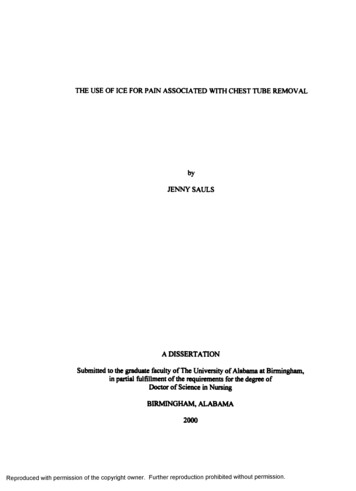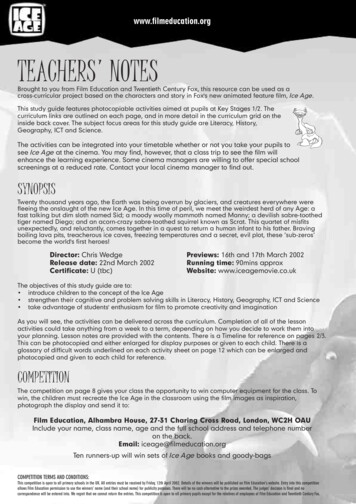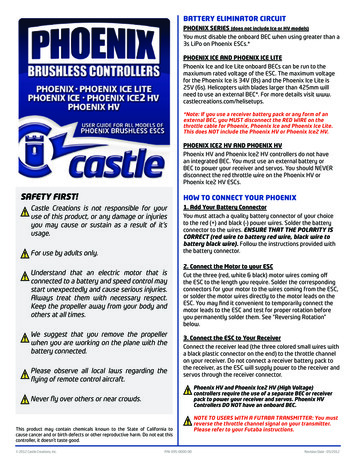
Transcription
THE USE OF ICE FOR PAIN ASSOCIATED WITH CHEST TUBE REMOVALbyJENNY SAULSA DISSERTATIONSubmitted to the graduate faculty o f The University of Alabama at Birmingham,in partial fulfillment of the requirements for the degree ofDoctor of Science in NursingBIRMINGHAM, ALABAMA2000Reproduced with permission of the copyright owner. Further reproduction prohibited without permission.
Copyright byJenny Sauls2000Reproduced with permission of the copyright owner. Further reproduction prohibited without permission.
ABSTRACT OF DISSERTATIONGRADUATE SCHOOL, UNIVERSITY OF ALABAMA AT BIRMINGHAMDegree D.S.N.Program Nursing EducationName of CandidateJennv SaulsCommittee ChairGail HillTitleThe Use of Ice for Pain Associated With Chest Tube RemovalThe purpose of this experimental study was to ascertain whether the application ofice would decrease pain before, during, and after chest tube removal (CTR) in adults whohave undergone cardiothoracic surgery. Fifty postcardiac surgery patients were randomlyassigned to 1 of 2 groups. Subjects in the experimental group received ice therapy (inde pendent variable) for 10 min before CTR, while subjects in the control group received aplacebo.The Multidimensional Conceptualization of Pain Framework and the theory thatice decreases nerve conduction velocity, thereby inhibiting pain impulses, provided thesupporting frameworks to guide the study. The investigator applied ice on either side ofthe chest tube(s) covering a 6 sq. in. area around the tube(s). The ice was applied directlyover one 4 x 4 in. gauze dressing and was secured with three 10-in. strips of 3-in. clothtape. The investigator was notified by the Nurse Practitioner (NP) or resident prior toCTR to provide time for the intervention. Pain intensity and pain distress (dependentvariable) were measured on a 0-10 Numeric Rating Scale (NRS), and pain quality wasmeasured using the McGill Pain Questionnaire-Short Form (MPQ-SF). Baseline meas ures of pain distress and pain intensity were taken before ice application (Time 1), icewas applied for 10 min, and pain intensity and pain distress were measured again imme diately prior to CTR (Time 2). Immediately after CTR, pain intensity and pain distressiiiReproduced with permission of the copyright owner. Further reproduction prohibited without permission.
were measured again (Time 3), and 10 min later pain intensity and pain distress weremeasured for the last time (Time 4). The patient was also asked to rate the quality of hisor her pain during CTR using the MPQ-SF at Time 4.The Repeated Measures Analysis of Variance (ANOVA) revealed no significantdifferences in pain intensity or pain distress between the experimental and control groups.A significant change in pain over time was noted in both groups with pain intensity anddistress being most severe during chest tube removal. Descriptive statistics indicate thatboth groups used all the quality descriptors on the MPQ-SF for the sensory and affectivecomponents of pain.ivReproduced with permission of the copyright owner. Further reproduction prohibited without permission.
ACKNOWLEDGMENTSI wish to express my sincere thanks to Dr. Gail Hill, Chairperson of my graduatecommittee, for her consistent encouragement and support of my research efforts and herwillingness to chair my doctoral committee. I also wish to thank Dr. Myra Smith and theother scholars who gave of their time to support and encourage my research efforts.These committee members were Dr. Dorothy Gauthier, who guided me through the painphysiology maze; Dr. A1 Bartolucci, who served as my statistical consultant; and Dr.Stephen Krau, whose constant support and encouragement served to keep me going on adaily basis. Each member of my committee made special contributions to this study, and Iowe much of my success to these individuals.I am grateful to Bo Mistak, Gretchen Ritter, and all the nurses who assisted withmy research efforts at the study site and offer my thanks for their support, time, phonecalls, and meetings to facilitate this project—I could not have completed it without them.My deepest and most heart-felt gratitude is extended to my family and those Iconsider family: Ted, my husband whose unending support and encouragement gave mestrength to complete this doctoral degree; my mother, who constantly boosted my morale;my dad, who traveled with me quite often from Tennessee to Alabama; Sheila Marquart,who provided constant emotional support and encouragement; my colleagues at MTSUSchool of Nursing; and MTSU, who provided financial support during my course ofstudy. I would also like to thank the students who assisted with my pilot study: EmilyvReproduced with permission of the copyright owner. Further reproduction prohibited without permission.
Barger, Lisa Breece, Andrea Cain, Stacy Edwards, Shanna Head, Amy Hudson, TerriRoach, and Amanda Whitlock.viReproduced with permission of the copyright owner. Further reproduction prohibited without permission.
TABLE OF CONTENTSPageABSTRACT. iiiACKNOWLEDGMENTS. vLIST OF TABLES. xLIST OF FIGURES. xiCHAPTER1INTRODUCTION.1Purpose.2Significance of the Problem.2Problem Statement. 3Conceptual Framework. 3Multidimensional Conceptualization of Pain.3Cold and Nerve Conduction Velocity.12Hypotheses. 13Assumptions. 14Definitions. 142REVIEW OF LITERATURE. 17Pain Management. 17Summary. 19Pain and Chest Tube Removal.20Summary.22Cold for Pain.23Summary. 353METHODOLOGY. 37Design.37Setting. 37Population and Sample. 38viiReproduced with permission of the copyright owner. Further reproduction prohibited without permission.
TABLE OF CONTENTS (Continued)PaceCHAPTERProtection of Human Subjects.38Instruments. 39Demographics. 39Pain Intensity. 39Pain Distress. 41Pain Quality. 41Procedure. 41Pilot Study 1. 44Pilot Study 2 . 45Data Analysis.46Limitations. 47Summary. 484FINDINGS. 49Hypothesis 1.50Hypothesis 2 .53Hypothesis 3.54Findings Relevant to Demographic Variables.55Summary of Findings. 575DISCUSSION, CONCLUSIONS,IMPLICATIONS, AND RECOMMENDATIONS.62Research Hypothesis 1. 62Research Hypothesis 2 . 64Research Hypothesis 3 . 65Findings Relevant to the Conceptual Frameworks.66The Multidimensional Conceptualization of Pain. 66Cold and Pain. 67Conclusions.68Implications.69Nursing Service. 69Nursing Research.70Recommendations. 70REFERENCES. 72viiiReproduced with permission of the copyright owner. Further reproduction prohibited without permission.
TABLE OF CONTENTS (Continued)PageAPPENDIXAPROCEDURE FOR CHEST TUBE REMOVAL.80BINFORMED CONSENT. 82CINSTITUTIONAL REVIEW BOARD APPROVAL. 89DDEMOGRAPHIC DATA. 92ENUMERIC RATING SCALE-PAIN INTENSITY.94FNUMERIC RATING SCALE-PAIN DISTRESS.96GMcGILL PAIN QUESTIONNAIRE-SHORT FORM (MPQ-SF).98HINSTITUTIONAL REVIEW BOARD-PILOT STUDY.1.100ixReproduced with permission of the copyright owner. Further reproduction prohibited without permission.
LIST OF TABLESTablePage1Age by Group. 502Demographic Characteristics of the Sample by Group. 513Means and Standard Deviations for Pain Intensity Over Time.524Means and Standard Deviations for Pain Distress Over Time.535Descriptive Statistics and Comparisons for MPQ Descriptors.566Frequency of MPQ Descriptors Used by Groups.587Premedication and Mean Pain Intensity Scores Over Time. 598Premedication and Mean Pain Distress Scores Over Time. 599Descriptive Statistics for Pain Intensity During CTR for NumberofCT. 60xReproduced with permission of the copyright owner. Further reproduction prohibited without permission.
LIST OF FIGURESFigure1PaceMean pain intensity during chest tube removal. 61xiReproduced with permission of the copyright owner. Further reproduction prohibited without permission.
CHAPTER 1INTRODUCTIONPain is a universal phenomenon (National Institute of Nursing Research (NINR),1994) and is the most common medical complaint among civilized populations (Waldman, 1992), consistently ranking among the most frequently used nursing diagnoses(Kim et al., 1984; Leslie, 1981; Martin & York, 1984; Silver, Halfmann, McShane, Hunt,& Nowak, 1984; Suhayda & Kim, 1984). Millions of people experience pain each year,and with ineffective management, pain is said to be “the most frequent cause of sufferingand disability for many people, significantly decreasing their quality of life” (WattWatson & Donovan, 1992, p. 3).Nurses claim to be concerned with increasing quality of life for their patients.Therefore, a desire to effectively manage the pain experience should be paramount intheir endeavors. Nurses have more consistent contact with patients than do any otherhealth care providers. This gives them a unique opportunity for making a valuable contri bution to the relief of pain (McCaffery & Beebe, 1989).The focus of this study was specifically related to pain associated with chest tuberemoval (CTR). While several studies have been done relating to this particular pain ex perience, research is lacking in the area of evaluation of interventions to alleviate thisproblem. For this reason, the investigator has chosen to study the effects of ice applica tion on pain associated with CTR in postoperative cardiothoracic surgery patients.1Reproduced with permission of the copyright owner. Further reproduction prohibited without permission.
In Chapter 1 of this manuscript, the author provides a statement of the purpose o fthe research, a description of the problem and its significance, research hypotheses, theconceptual frameworks to be used as guidelines for conducting the research, assumptionsassociated with the study, and definitions of terms. Chapter 2 includes a literature reviewon pain management, pain associated with CTR, and ice as an intervention for pain. InChapter 3, the author outlines the design of the study along with a description of thepopulation and sample, procedures to be used, and statistical analyses to be employed.Chapter 4 includes a report of the findings in relation to demographics of the sample andresearch hypotheses. In Chapter 5, the author provides a discussion of the interpretationof results, implications, and conclusions.PurposeThe purpose of this study was to ascertain whether the application of ice woulddecrease pain intensity, distress, and quality before, during, and after CTR in adult pa tients who have been admitted to postoperative acute and critical care areas after cardiothoracic surgery.Significance of the ProblemEvery year, more than 300,000 patients undergo caidiothoracic surgery (Ameri can Heart Association, 1997), which may include coronary artery bypass grafting(CABG), valve replacement or repair, or repair of structural defects. Each of these proce dures requires placement of at least one chest tube. Removal of these chest tubes has beendescribed as one of the worst Intensive Care Unit (ICU) experiences for these patientsReproduced with permission of the copyright owner. Further reproduction prohibited without permission.
3(Paiement, Boulanger, Jones, & Roy, 1979), and the pain associated with CTR has beenpoorly controlled (Carson, Barton, Morrison, & Tribble, 1994; Gift, Bolgiano, & Cun ningham, 1991; Kinney, Kirchhoff, & Puntillo, 1995; Puntillo, 1994). Many patients re ceive no preprocedural pain medication (Kinney et al., 1995), and, for those who do, paincontrol is often not achieved (Carson et al., 1994; Gift et al., 1991; Puntillo, 1994, 1996).Problem StatementWill the application of ice decrease pain intensity, distress, and quality before,during, and after CTR in adult patients who have been admitted to acute and critical careareas after cardiothoracic surgery?Conceptual FrameworkMultidimensional Conceptualization of PainPain is a multidimensional concept (NINR, 1994) and may be described as acomplex phenomenon that involves a combination of physical and psychological eventsthat may be affected by sociocultural phenomena. A multidisciplinary priority-expertpanel was convened to review current pain management practices in order to set prioritiesfor future research. The panel of experts established by the NINR, who were chargedwith studying assessment and management of the pain experience, support the use of thismultidimensional model for many types of pain. The model includes six elements: physi ologic, sensory, affective, cognitive, behavioral, and sociocultural. The physiologic com ponent is pertinent to the proposed study because the application of ice affects neuralconduction of pain impulses (Abramson et al., 1966; Clarke, Hellon, & Lind, 1958; Lee,Reproduced with permission of the copyright owner. Further reproduction prohibited without permission.
4Warren, & Mason, 1978). The physiologic dimension will be explicated in the followingparagraphs; however, physiologic parameters were not measured as pain is a subjectiveand personal experience that is best measured by the individual's self-report of the expe rience (Katz & Melzack, 1999). The sensory and affective dimensions of pain were as sessed in this study and will be explicated in the following paragraphs. The cognitive,behavioral, and sociocultural dimensions will be discussed briefly in this review but werenot evaluated in the study. Although assessment of each dimension would present a morecomplete picture of the pain experience, the nature of the environment and acuity of thepatients involved in this study limited the time frame for completing the pain assessment.Physiologic dimension. Structural, functional, and biochemical aspects of the painexperience as well as the different types of pain are included in the physiologic dimen sion. Perception and transmission of pain by way of nociceptors along ascending and de scending pathways facilitated by neurochemical mediators are important components ofthe physiologic mechanisms of the pain experience. Duration and pattern are also impor tant components of this dimension (NINR, 1994). Distinctions among the different typesof physiologic pain are discussed in the following paragraphs.Fast pain, also known as brief, momentary, or transient (Melzack, 1975), sharp,pricking, acute, or electric pain that is well-localized, occurs within 1/10 s after the painstimulus occurs and is not felt in most of the deeper tissues. Acute or fast pain may becaused by any thermal or mechanical stimulus and is transmitted by A-delta fibers withendings that secrete glutamate. If A-delta fibers are blocked by moderate compression ofthe nerve trunk, fast pain disappears (Guyton & Hall, 1996).Reproduced with permission of the copyright owner. Further reproduction prohibited without permission.
Whipple (1990) defines chronic pain, also known as slow pain, as pain that lastsfor more than 6 months. Slow pain is continuous, steady, constant (Melzack, 197S),burning, aching, throbbing, nauseous, or chronic pain that is poorly localized, begins afterat least 1 s of painful stimulus, and increases slowly over seconds to minutes (Guyton &Hall, 1996). Slow pain is usually associated with tissue destruction and can occur in skin,deep tissues, and organs. It may be described as excruciating, leading to prolonged andunbearable suffering. Slow or chronic pain, which may be elicited by mechanical, ther mal, or chemical stimuli, is transmitted by way of C-fibers. When C-fibers are blocked bylocal anesthetic, chronic aching pain disappears.According to Guyton and Hall (1996), physiologic pain is primarily a protectivemechanism occurring in response to tissue damage and resulting in withdrawal from thepain stimulus. The cause may be ischemia, muscle spasm, or chemicals released as tissuedamage occurs. Pain receptors are free nerve endings and are prevalent in the skin, peri osteum, arterial walls, joint surfaces, and falx and tentoruim of the cranial vault. Otherdeep tissues have significantly fewer pain receptors but can elicit painful sensationsnonetheless. Unlike other sensory receptors in the body, pain receptors are nonadaptive innature. Often, pain receptors become increasingly sensitive as the painful stimulus per sists, creating a hypersensitivity or hyperalgesia. This mechanism is also protective, as itcontinues to remind the body that tissue damage may be occurring as long as the painpersists.Pain receptors may be excited by mechanical, thermal, or chemical stimuli. Me chanical and thermal stimuli can elicit both acute and chronic pain, whereas chemicalstimuli usually elicit only chronic pain. Substances like bradykinin, serotonin, histamine,Reproduced with permission of the copyright owner. Further reproduction prohibited without permission.
potassium ions, acids, acetylcholine, and proteolytic enzymes are examples of chemicalsthat may stimulate chronic pain. Prostaglandins and substance P.are capable of enhancingsensitivity of the nerve endings; however, they do not have the ability to directly excitethe pain receptors (Guyton & Hall, 1996).As documented in Guyton and Hall (19%), two separate pathways are used fortransmitting pain signals to the brain, and these pathways correspond to the types of pain.Acute or fast pain is transmitted from the periphery to the spinal cord by way of A-deltafibers and from the spinal cord to the brain by way of the neospinothalamic tract. Chronicor slow pain is transmitted from the periphery to the spinal cord by way of C fibers andfrom the spinal cord to the brain by way of the paleospinothalamic tract.When excited by mechanical or thermal stimuli, pain receptors in the peripherytransmit the impulses to the spinal cord by way of A-delta fibers. These fibers terminateon neurons of lamina I in the dorsal hom of the cord where they excite second-order neu rons of the neospinothalamic tract. Glutamate is believed to be the neurotransmitter se creted by the A-delta nerve endings and has a rapid onset and short duration, which ex plains the timing of fast or acute pain. The second-order neurons give rise to long fibers,which carry the impulse over to the contralateral side of the cord and up to the brain.Some of the long fibers terminate in the reticular area of the brain stem; however, mostterminate in the thalamus. From these areas, the impulse is transmitted to other areas ofthe brain and somatic sensory cortex where the stimulus is interpreted as pain (Guyton &Hall, 1996).Chronic or slow pain receptors are excited by chemical stimuli and sometimes bypersistent mechanical or thermal stimuli. C fibers in the periphery transmit these impulsesReproduced with permission of the copyright owner. Further reproduction prohibited without permission.
7to the spinal cord where they terminate mostly in laminas II and III of the dorsal hom.Substance P is believed to be the neurotransmitter secreted slowly by these nerve end ings, which explains the timing of slow or chronic pain. This area, known as the substan tia gelatinosa, gives rise to the long fibers, which join the fibers from the fast tract andascend to the brain in the same manner. Some long fibers do not cross to the contralateralside but proceed to the brain on the same side. Most of the neurons that transmit slowpain terminate in the brain stem, and from here the pain signals travel to the thalamus,hypothalamus, and other adjacent structures where the interpretation of pain occurs(Guyton & Hall, 1996).Individuals respond differently to pain in part because of an internal mechanismcalled the analgesia system that has the ability to suppress or inhibit pain signals. Thissystem has three basic components that are located in the pons, medulla, and the dorsalhorns of the spinal cord. As pain signals descend from the brain to the spinal cord andenter the pain inhibitory complex in the dorsal hom, the signals can be blocked. There areseveral neurotransmitters involved in this process as well. Enkephalin and serotonin arereleased at various areas along the descending pathway. Serotonin stimulates the releaseof enkephalin, which inhibits both A-delta and C fibers and blocks calcium channels thatwould normally secrete transmitter to perpetuate the pain impulse, thus blocking addi tional pain impulses from reaching the brain (Guyton & Hall, 1996).Physiologic responses to pain that occur as a result of sympathetic nervous systemactivity may include increased heart rate, blood pressure, cardiac contractility, and respi ratory rate, as well as diaphoresis, pupil dilation, and pallor. Other possible manifesta tions include decreased intestinal motility and urinary retention. The body’s response toReproduced with permission of the copyright owner. Further reproduction prohibited without permission.
8stress will result in increased blood glucose, cortisol, antidiuretic hormone, and aldoster one levels (Cousins, 1989). Some of these parameters may be used for assessment ofacute pain; however, subjective measures of pain assessment are more valid (Katz &Melzack, 1999).Sensory dimension. According to the NINR (1994), the sensory dimension of painrefers to location, intensity, and quality. When assessing location, anatomic structuresand landmarks are addressed and may assist in determining the etiology of the pain. In tensity refers to the amount or severity of pain being experienced and may be assessedusing numerical pain rating scales or with word scales using terms such as mild, moder ate, and severe. Factors like etiology, tolerance, and pain threshold can influence painintensity. Quality is related to what the pain feels like and may be influenced by etiology,indicating that different types of pain may have different sensory qualities.The McGill Pain Questionnaire (MPQ) (Katz & Melzack, 1999; Melzack, 1987)is a pain assessment tool used for evaluating the quality of pain. This multidimensionaltool includes words used for assessing the sensory qualities in terms of temporal, spatial,pressure, and thermal properties. Words like throbbing, shooting, stabbing, sharp, gnaw ing, cramping, pulling, burning, and tingling are used to describe the sensory quality ofthe pain experience. These descriptors may also be related to different pain syndromes oretiologies (NINR, 1994). Somatic pain may be described as sharp or stabbing, whereasvisceral pain may be described as dull or aching (Guyton & Hall, 1996).Reproduced with permission of the copyright owner. Further reproduction prohibited without permission.
9Affective dimension. While emotional distress may be considered a component ofpain, it may also be a consequence or cause as well as a concurrent phenomenon with en tirely independent sources. The affective component of pain is the dimension that in volves suffering (Craig, 1989; Loeser & Melzack, 1999; NINR, 1994) and may includeemotions such as fear, depression, anxiety, anger, relief, anticipation, aggression, andpersonality characteristics. It may be these signs of emotional distress that enable the ob server to recognize the presence of pain.Though a number of emotions are associated with the pain experience, Peck(1986) identified anxiety as the psychological variable most related to pain. Fear of theunknown and fear of death are often associated with acute postoperative pain and traumapain. Adequate preparation of the patient and allowing the patient to assume some controlof the situation have been documented as successful methods for decreasing anxiety.The MPQ (Katz & Melzack, 1999) includes a section containing words used forassessing the affective qualities in terms of tension, fear, and autonomic properties.Words like tiring, exhausting, sickening, fearful, punishing, cruel, and wretched are usedto describe the affective or emotional quality of the pain experience. The MPQ is widelyused for clinical practice and research.Several studies have been conducted addressing the affective or emotional aspectsof the pain experience (Gift et al., 1991; Puntillo, 1990,19%). Still, it remains more elu sive than the physiologic and sensory dimensions (NINR, 1994).Cognitive dimension. Cognition has been defined as “awareness with perception,reasoning, judgement, intuition, and memory; the mental processes by which knowledgeReproduced with permission of the copyright owner. Further reproduction prohibited without permission.
10is acquired” (Thomas, 1997, p. 411). The cognitive dimension of pain involves the indi vidual’s perception of self; the meaning of pain, knowledge, attitude, and belief aboutpain and pain therapy; and personal preferences and coping strategies. Also included inthis dimension are the level and quality of cognition of the individual as they relate to hisor her ability to self-report pain. Individuals with limited or impaired cognitive function,such as infants, those with learning disabilities, confused patients, or those with dementia,may lack the ability to report their pain adequately. The few studies regarding the cogni tive dimension of pain fail to provide a comprehensive understanding of this dimension(
who provided constant emotional support and encouragement; my colleagues at MTSU School of Nursing; and MTSU, who provided financial support during my course of study. I would also like to thank the students who assisted with my pilot study: Emily v Reproduced with permission of the copyright owner. Further reproduction prohibited without .











